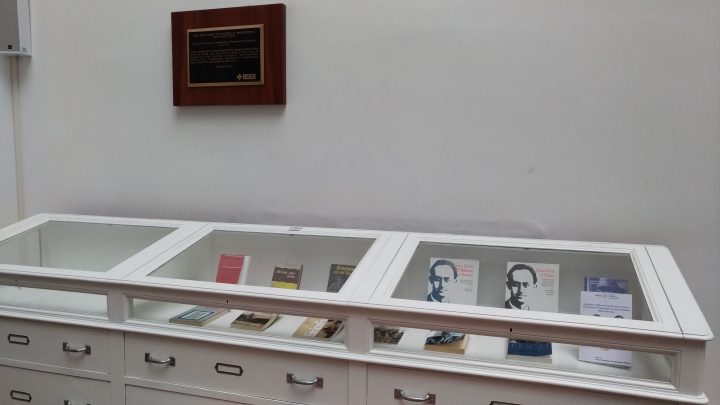Enrico Fermi was born in Rome on Sunday September 29, 1901. During high school, he developed a deep interest in physics. He was then suggested by a colleague of his father, engineer Adolfo Amidei, to take the admission test for the prestigious Scuola Normale Superiore, which he effectively passed, first in the ranking, in 1918. He attended both the School and the University of Pisa, graduating in physics in 1922.
After short visiting periods of study in Göttingen and Leiden he joined the University of Florence in 1924, where in 1926 he developed the Fermi-Dirac statistics, and then moved to Rome, where he was appointed Professor of theoretical physics (the first academic chair in Italy in that field, sponsored by Orso Mario Corbino).

IEEE Milestone celebrating Enrico Fermi’s Statistics – School of Engineering, Florence (Italy)
Fermi and his group of via Panisperna boys made a fundamental discovery in 1934, in the field of radioactivity, regarding the so called slow neutrons.
Fermi left Italy in 1938, after the proclamation of the racial laws of the fascist regime, with his wife Laura Capon, who was Jewish.
After a short trip to Stockholm, to receive the Nobel Prize in Physics, he eventually turned to America, having accepted an academic position at Columbia University.
On December 2, 1942 Fermi, coordinating a group of scientists, succeeded in making the first human-made self-sustaining nuclear chain reaction with the Chicago Pile-1, under the west viewing stands of the original Stagg Field. After the discovery of fire by humans, hypothetically about 125,000 years ago, the nuclear era had begun.
During the WWII, he joined many other scientists in the Manhattan Project in Los Alamos, under the supervision of Robert J. Oppenheimer, which developed the atomic bombs detonated in Hiroshima and Nagasaki, killing between 129,000 and 226,000 people, on August 6 and 9 respectively, 1945.
During the summer of 1954 Fermi, after a trip in Italy (where he taught at the International School of Physics in Varenna) and South America, feeling ill went to Billings Hospitals in Chicago. He was visited by a intern doctor who didn’t make the correct diagnosis. A further visit by a chief surgeon, and an exploratory operation, revealed an incurable stomach cancer.
Emilio Segrè, who soon came to visit Fermi at hospital, recalls:
“I found Fermi at Billings Hospital, fed by a tube that ran directly into his stomach. The patient was measuring the flow of the fluid by counting the drops, using a stopwatch, as though performing a physiology experiment. He was perfectly aware of his condition and started talking about how many months or weeks he might survive, and what he would do in the short span still allotted him.[…] In a lighter vein, he told me he had been blessed by a Catholic priest, a Protestant pastor, and a rabbi. At different times the three had entered his room and demurely and politely asked permission to bless him. He had given it. ‘It pleased them and did not hurt me’, he added.[…] Among other things, Fermi observed that since his wife, Laura, had just finished her book Atoms in the Family, his death would come at the right moment for promoting it, and that he hoped the literary success he anticipated for it might help her overcome the difficult time she faced. At the end of the afternoon I left. When I got out of the hospital, I felt ill; the emotional upheaval produced in me by the visit was too much for my constitution. I could scarcely stand, and I remember going into the first bar I came across to fortify myself with a cognac, something exceedingly rare, perhaps even unique, in my life. I returned to Berkeley gravely upset, and as soon as possible I went back to Chicago. I found Fermi much worse and in a more somber mode. He spoke of his sufferings and of other subjects I will omit. We talked until late in the evening. During the night, I was awakened by a phone call announcing that Fermi had died”. [1]
It was Sunday November 28, 1954 and Enrico Fermi, one of the greatest physicists of modern history, was 53 years old.
At the memorial service St. Francis’ Cantico delle creature (“Canticle of the Creatures”) was read.
References:
[1] E. Segrè, A mind always in motion: The autobiography of Emilio Segrè, Plunkett Lake Press, 1992.
